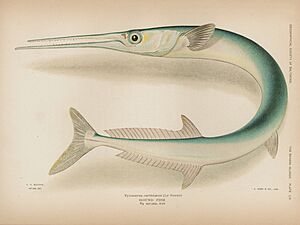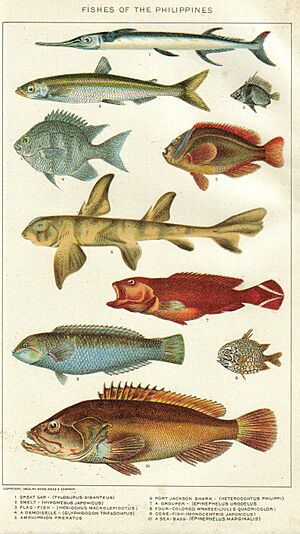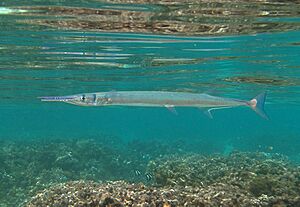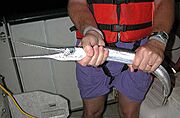Houndfish facts for kids
Quick facts for kids Houndfish |
|
|---|---|
 |
|
| Illustration from The Bahama Islands by The Geographical Society of Baltimore 1905. | |
| Conservation status | |
| Scientific classification |
The houndfish (Tylosurus crocodilus) is a large, fast fish found in warm ocean waters. It's known as a game fish because people like to catch it for sport. This fish belongs to the family called Belonidae, which are often called needlefish because of their long, thin bodies and pointy jaws. The houndfish is the biggest member of its family. It can grow up to about 5 feet (1.5 meters) long and weigh around 10 pounds (4.5 kg). Sometimes, people also call it the crocodile needlefish.
What Does a Houndfish Look Like?
The houndfish has a long, strong body that looks a bit like a cylinder. It has a dark blue back and shiny silver-white sides, with a plain white belly. Its head is shorter than other needlefish.
Even though it doesn't have sharp spines, its dorsal fin (the one on its back) has 21 to 25 soft rays. Its anal fin (the one on its underside) has 19 to 22 soft rays. Houndfish also have many bones in their back, called vertebrae, usually between 80 and 86 of them.
A special way to tell a houndfish apart from other similar fish is by its teeth. When a young houndfish is small, its teeth point forward. In other needlefish, the teeth are straight at all ages. The houndfish also has a clear ridge, like a small keel, on the narrow part of its body before the tail. Its tail fin is deeply forked, like a "V" shape. Young houndfish have a distinct black spot on the back part of their dorsal fins. The longest houndfish ever recorded was about 5 feet (150 cm) long, and the heaviest weighed about 14 pounds (6.35 kg).
Where Do Houndfish Live?


Houndfish live in many warm parts of the world's oceans. In the Indian and Pacific Oceans, you can find them from the Red Sea all the way to French Polynesia. They are also found north near Japan and south near New South Wales, Australia. In the eastern Pacific, a similar fish called the Mexican needlefish takes its place.
In the western Atlantic Ocean, houndfish swim from New Jersey down to Brazil. In the eastern Atlantic, they are found near places like Cameroon, Liberia, and Ascension Island. They can also be seen near Guinea, Senegal, and Cape Verde. Interestingly, some houndfish have even moved into the eastern Mediterranean Sea from the Red Sea through the Suez Canal. This movement of species is called Lessepsian migration.
Houndfish are pelagic animals, which means they live in the open ocean, not usually near the bottom. They can be found over lagoons and near reefs, either swimming alone or in small groups. They mostly eat smaller fish.
Life Cycle
When houndfish lay their eggs, the eggs have special tendrils on their surface. These tendrils help the eggs stick to objects floating in the water, keeping them safe until they hatch.
Houndfish and People
People enjoy catching houndfish for sport, especially at night using artificial lights, similar to how other needlefish are caught. While houndfish are considered good to eat and are often sold fresh, they are not very popular in markets. This is because their flesh has a greenish color, which can look a bit unusual, even though it tastes good. The current world record for a houndfish caught by an angler weighed 10 pounds, 12 ounces (4.88 kg). It was caught in the Bahamas in 2013.
Houndfish can be a bit dangerous, especially for fishermen. They are large and have a tendency to leap out of the water, especially when they are scared or attracted to lights. Their long, pointy beaks can cause puncture wounds. For example, in 2000, a woman snorkeling in Florida was hurt when a houndfish jumped out of the water and stabbed her in the neck. In 2010, a person in a kayak was injured when a houndfish jumped and hit them in the back, causing a serious injury.



